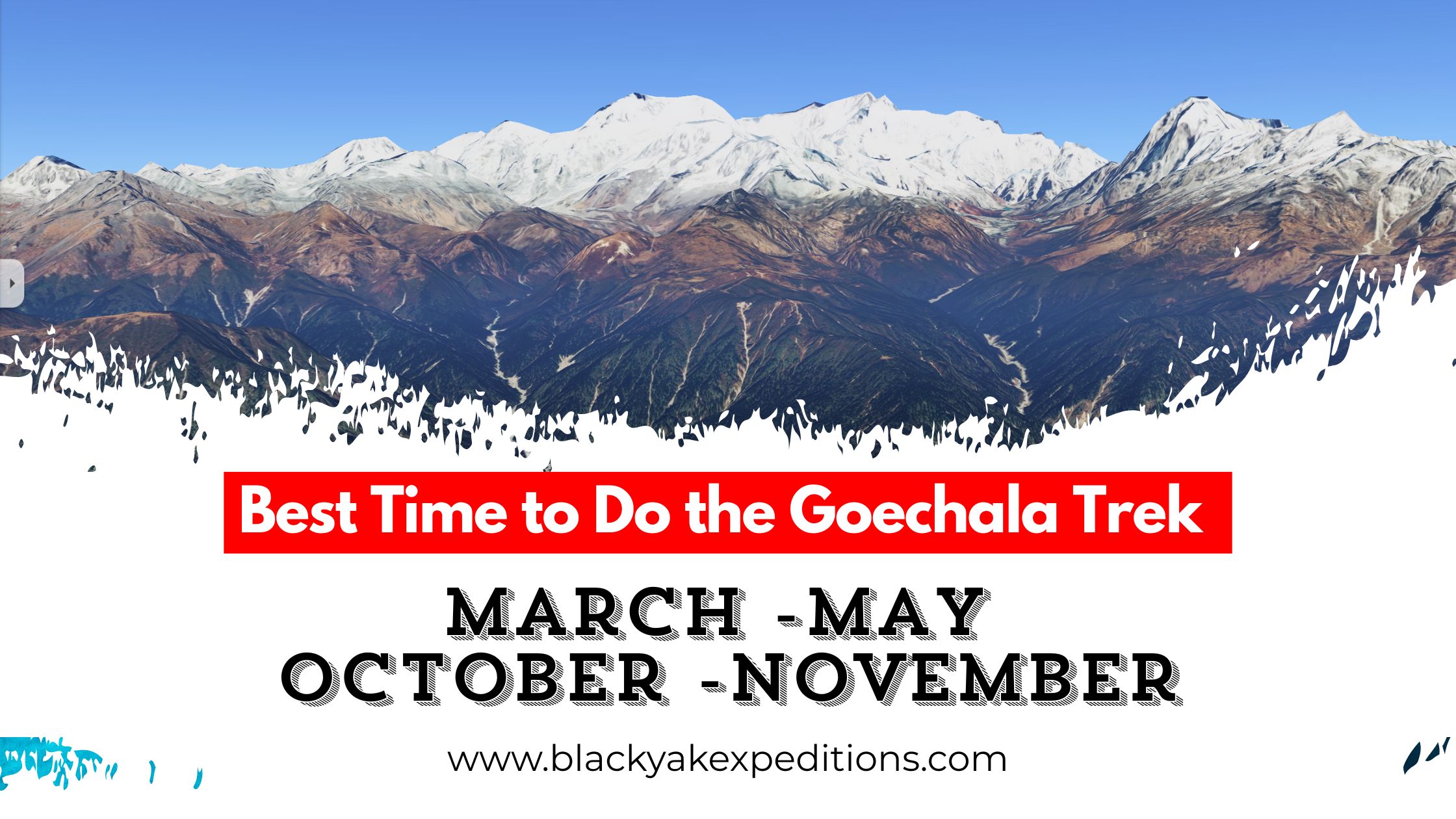Best Time to Do the Goechala Trek
Determining the best time to do the Goechala Trek is absolutely crucial for a successful Himalayan adventure. The weather in Sikkim can be unpredictable, and in the mountains, conditions can change rapidly without warning. Poor timing can completely ruin what should be a once-in-a-lifetime experience.
We’ve encountered extensive misinformation online about the Goechala Trek best time. Some articles incorrectly claim this adventure can be done year-round, which is simply false. Most content lacks proper research, leading many trekkers to disappointing experiences due to poor timing decisions.
October and November represent the best time to do the Goechala Trek. During these prime months, you’ll experience minimal rainfall, crystal-clear skies, and while the Himalayas remain cold, temperatures stay manageable.
Autumn Season – Best Time for Goechala Trek
October to November: Optimal Time to Visit
October stands as the premier month for this high-altitude adventure. The benefits include:
- Crystal Clear Visibility: Post-monsoon clarity offers unobstructed views of the Kanchenjunga massif
- Stable Weather Patterns: Minimal precipitation and predictable conditions
- Comfortable Temperatures: Daytime ranges from 5°C to 15°C at lower altitudes
- Perfect Photography: Sharp mountain visibility ideal for capturing memories
- Reliable Trails: Dry, stable paths without monsoon-related hazards
November continues this excellent window with maintained visibility and gradually cooler but manageable temperatures. You’ll encounter fewer crowds and stable weather systems with reduced chance of sudden changes. Many experienced trekkers consider November among the best months for this high-altitude adventure.
Why Autumn is the Best Time to Do the Goechala Trek
Weather Stability: This period represents the ideal Goechala Trek best time due to post-monsoon conditions when the atmosphere stabilizes. The retreating monsoon leaves behind clear, dry air perfect for mountain viewing.
Safety Considerations: Understanding the best time to do the Goechala Trek means recognizing that autumn offers minimal risk of landslides, flooding, or weather-related hazards that plague other seasons. Trail conditions remain consistently safe throughout this period.
Temperature Balance: While nights become progressively colder at higher camps like Dzongri and Thangshing, daytime temperatures during the optimal trekking season remain comfortable for sustained hiking activities.
![Informative infographic titled “Goechala Trek Best Time” visually highlighting the best time to do the Goechala Trek. Features a mountain illustration representing seasonal changes, with key information blocks stating the recommended trekking seasons: Autumn (October to November) and Spring (March, April, May). Also notes months to avoid due to monsoon: June to September. Image by blackyakexpeditions.com, ideal for guiding trekkers on planning the best time to do the Goechala Trek.]() Spring Season – Alternative Best Time for Goechala Trek
Spring Season – Alternative Best Time for Goechala Trek
March to May: Secondary Optimal Time
Spring provides an alternative timing with unique attractions:
March – Early Spring:
- Rhododendron Blooms Begin: Lower altitude flowering creates spectacular scenery
- Moderate Transition: Gradual warming from winter conditions
- Extended Daylight: Longer trekking windows and better camping conditions
April – Peak Beauty:
- Full Floral Display: Perfect timing for flower enthusiasts seeking the best time to do the Goechala Trek
- Optimal Temperature Balance: Warmer days with manageable nights
- Wildlife Activity: Increased bird and animal sightings
May – Late Spring:
- Pre-Monsoon Period: Still considered good timing but requires careful weather monitoring
- Comfortable Camping: Warmer conditions at higher altitudes make this an appealing time to visit
- Generally Clear Views: Good visibility before monsoon clouds arrive
Spring Weather Patterns During Best Time
Temperature Ranges: Spring typically offers 0°C to 20°C at various altitudes, making it more comfortable than autumn’s colder conditions for those seeking the best time to do the Goechala Trek with warmer weather.
Weather Patterns: Early spring maintains excellent conditions with minimal rainfall, though late May shows increased precipitation as monsoon approaches, affecting the ideal trekking window.
Trail Features: Spring paths during this optimal time showcase blooming vegetation, gradually improving accessibility as snow melts, and generally stable conditions perfect for mountain photography.
Winter – Why It’s Not the Best Time to Do the Goechala Trek
December: Limited Window for Trekking
Early December: The first two weeks might be possible, though success rates decline significantly compared to the best time to do the Goechala Trek in autumn.
Success Statistics:
- First three weeks of December: 70% success rate
- Last week of December: Only 10% success rate
- January: Mere 1% success rate
- February: 1% success rate
Winter Challenges – Avoiding Poor Timing
Extreme Conditions: Winter presents serious obstacles including temperatures dropping to -15°C, ice-covered paths creating safety hazards, and standard gear proving inadequate. This clearly demonstrates why winter isn’t the best time to do the Goechala Trek.
Logistical Issues: Horses and yaks relocate to lower elevations, requiring expensive human porters. Many trail sections become completely impassable, making this period unsuitable for trekking.
Equipment Demands: The extreme cold requires specialized gear far beyond normal trekking equipment, significantly increasing costs and complexity compared to the optimal trekking season.
Monsoon Season – Worst Time for Trekking
June to September: Never Attempt During This Period
Peak Monsoon Hazards: These months present the worst possible conditions:
June through August:
- Heavy Rainfall: Sikkim receives maximum annual precipitation
- Landslide Dangers: Mountainous terrain becomes extremely hazardous
- Trail Deterioration: Paths turn muddy, slippery, and dangerous
- Zero Visibility: Cloud cover eliminates mountain views entirely
September Issues:
- Continued Impact: Late monsoon effects persist
- Recovery Period: Trails need time to dry and stabilize
- Erratic Weather: Unpredictable transition conditions
Why Monsoon is the Worst Time to Visit
Stream Conditions: The numerous streams become violent torrents, making crossings dangerous or impossible – the complete opposite of conditions during the best time to do the Goechala Trek.
Visibility Problems: Constant cloud cover eliminates the spectacular mountain views that make this trek worthwhile, contrasting sharply with the clear skies of optimal trekking months.
Safety Risks: Landslides and road blockages create life-threatening situations throughout the region, emphasizing why this period contradicts every aspect of the ideal Goechala Trek best time.
Planning Your Trek During Optimal Time
Booking Considerations for Best Time Periods
Advance Reservations: Popular months require early booking, particularly October and November when demand peaks among experienced trekkers seeking the best time to do the Goechala Trek.
Flexibility: Even during optimal seasons, maintain some schedule flexibility for minor weather-related adjustments to ensure you experience the trek during ideal conditions.
Equipment Needs: Regardless of choosing autumn or spring as your preferred time to visit, proper cold-weather gear remains essential for high-altitude camps where temperatures drop significantly.
Maximizing Your Experience
Photography Opportunities: Optimal months offer unparalleled photographic conditions with clear mountain views and stable lighting.
Physical Preparation: Maintain excellent fitness regardless of timing, as altitude and terrain challenges persist year-round.
Cultural Elements: Prime seasons often coincide with local festivals and cultural activities, enhancing your overall Himalayan experience.
Expert Recommendations
Based on extensive local experience and weather analysis, October emerges as the single best month, followed closely by November. For those preferring warmer conditions and floral displays, April represents the optimal spring choice when considering the best time to do the Goechala Trek.
Critical Avoidance: Never attempt this trek during January, February, or monsoon season (June-September). These periods offer virtually no chance of successful completion and present serious safety risks.
Final Advice: When planning the Goechala Trek best time, schedule your adventure during October-November or March-April to ensure the highest success and the most rewarding mountain experience possible. The difference between optimal and poor timing can mean the difference between a lifetime memory and a disappointing, potentially dangerous experience.



 Spring Season – Alternative Best Time for Goechala Trek
Spring Season – Alternative Best Time for Goechala Trek